
Lawn diseases and fungi can have significant detrimental effects on the health and appearance of grass. Ignoring or neglecting these issues can result in long-term damage and even the loss of your lawn. Understanding the effects is essential in order to take the necessary steps for prevention and treatment.
Weakened Grass
Lawn diseases and fungi can weaken your grass, making it more susceptible to further damage. These issues often attack the roots and leaves of the grass, hindering its ability to absorb nutrients and water. As a result, the grass becomes stressed, leading to thinning, yellowing, and eventually, death.
Patchy Turf
One of the noticeable effects of an unhealthy lawn is the development of patchy areas on your turf. This occurs as the diseases or fungi spread and destroy the grass in specific spots. These patches can become unsightly and disrupt the overall aesthetic appeal of your lawn.
Reduced Growth and Vigor
Lawn diseases and fungi can inhibit the growth and vigor of your grass. Infected grass may experience stunted growth, leading to a lack of lushness and density. This can create an uneven appearance and make your lawn more susceptible to weed growth.
Spread to Surrounding Areas
If left untreated, lawn diseases and fungi can spread to other areas of your lawn and even neighboring lawns. They can be easily transmitted through water, wind, or foot traffic, making it crucial to address the issue as soon as possible to prevent further infestation.
Increased Weed Invasion
Diseased or weakened grass provides an ideal environment for weeds to take hold. Weeds can quickly occupy the empty spaces left by dying or damaged grass, further crowding out the desirable grass species. This can lead to a decline in the overall quality and appearance of your lawn.
Costly Lawn Restoration
If the lawn diseases and fungi are left untreated for an extended period, they can cause irreversible damage, requiring costly restoration efforts. This may involve reseeding or sodding large areas of your lawn, which can be time-consuming, labor-intensive, and expensive.
By understanding the detrimental effects, you can take proactive measures to prevent and address these issues. Regular lawn maintenance practices such as proper watering, fertilization, and mowing can help promote a healthy and resilient lawn. Additionally, consulting a professional weed control service or a local extension office can provide accurate diagnosis and effective treatment solutions tailored to your specific lawn conditions.
Remember, early detection and prompt action are vital in mitigating the damaging effects of lawn diseases and fungi and preserving the beauty and vitality of your grass.
Let’s Get Started
Site Design: © Copyright Forge Media™